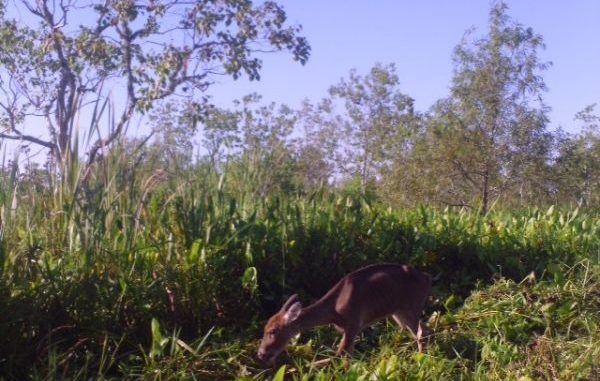
Southcentral, Southeast Louisiana hit particularly hard, LDWF veterinarian says.
LouisianaSportsman.com user “papa-p” was shocked when he checked his trail camera recently and found a photo of what could only be described as a very sick deer.
“Hate seeing this picture on trail cam,” papa wrote on Oct. 12. “We had also found a young deer dead last month.”
User “sportsman0917” worried it could be chronic wasting disease spreading from Texas, while “fishfearme!” commented that he has seen reports online of numbers of deer dead around Lacassine National Wildlife Refuge and in St. Martin Parish.Dr. Jim LaCour, the state wildlife veterinarian with the Louisiana Department of Wildlife & Fisheries, confirmed today (Oct. 15) that deer across the state have been hit particularly hard this year — but fortunately the culprit isn’t chronic wasting disease.
“We’ve got a bunch of hemorrhagic disease going on,” LaCour told Louisiana Sportsman. “We’re getting reports from all around, but Southcentral to Southeast Louisiana probably have been more represented; that may be caused by more disease (in those areas), or or that may be because more people are finding them.”
The disease, a close relative to blue tongue, isn’t anything new.
“If you look over the course of time, (hemorrhagic disease) kind of waxes and wanes,” LaCour said. “This happens to be one of those years when we have a lot of it.”
But his year’s outbreak seems to be a bad one in comparison to recent years. To date, 100 reports of dead deer have been made to the LDWF, LaCour said.
Hemorrhagic disease affects all age groups of deer, and there are three factors that have roles to play in the severity of an outbreak, he said.
“Flooding plays a part in an outbreak because it’s a vector-born disease spread by gnats, it’s a disease that can be exacerbated by new viruses, and it is more prevalent when we have a wet spring and a dry June,” LaCour said. “It just happens that we had all three of those this year.
This year’s spring was wet, while June was dry; mark off one of the necessary factors for a major outbreak.
LaCour said sampling as revealed this year’s outbreak is caused by a new strain of the disease; tick off another factor.
And, of course, severe flooding in Southeast and parts of Southcentral Louisiana in the wake of Hurricane Isaac bunched deer up on small areas of dry ground.
“If all of your deer are very spread out they are less likely to be infected than if they are pushed up on ridges,” LaCour said. “We had all three factors come into play this year.”
Lacour said there are three forms of hemorrhagic disease.
“There is the peracute form,” LaCour said. “Those deer look perfectly healthy, except they’re down or dead.”
And then there’s the deer that just look awful.
“There’s the accute form, and those deer may be breathing rapidly; they may have ulcers in their mouths or lesions on their hooves,” LaCour explained. “Those deer will usually die.”
And then there are some deer that have been impacted and seemingly recovered, only to die a long, slow death.
“There’s the chronic form,” LaCour said. “Those are deer that live through the initial disease, but they have suffered from a real high fever that has damaged their stomachs, and they can’t absorb nutrients. They loose a bunch of weight and get real skinny.
“I get pictures every year of deer at feeders just eating, eating and eating, but they die of malnutrition because they can’t absorb the nutrients.”
The bottom line is that hunters shouldn’t be surprised if they find dead deer — or deer that look like they will die soon — while out an about this season.
But hunters shouldn’t be overly concerned that they will serve their family dangerous meat.
“It’s not ever been shown to be contagious to humans,” LaCour said.
Of course, a bit of common sense is in order, he said.
“If a deer looks healthy and acts healthy, then it’s fine,” LaCour said. “If a deer is sick, if it’s got multiple ulcers or lesions, it’s best to chunk it.”
Deer management practices probably don’t need to be altered, either. In fact, LaCour pointed out that, even though this is a severe outbreak, the LDWF is not considering any changes to hunting regs.
“Overall, it’s part of the normal cycle,” he said. “If you find three deer on your place, there are probably some more. If you have 4,000 acres, you might have 10 more. But that’s not a significant impact, so for the most part there’s no need to for any management considerations.”
LaCour said dead deer can be reported to the nearest LDWF regional office, and any freshly dead deer will be sampled.
Of course, not all dead deer are victims of the disease.
“If it’s by the road, it probably got hit by a car,” LaCour said. “If it’s in the woods it’s probably hemorrhagic disease.”


